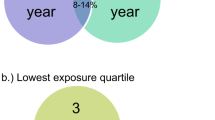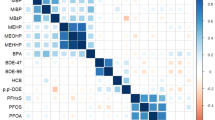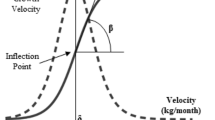Abstract
Background
Children’s prenatal exposure to multiple environmental chemicals may contribute to subsequent deficits in impulse control, predisposing them to risk-taking.
Objective
Our goal was to investigate associations between prenatal exposure mixtures and risk of teen birth, a manifestation of high-risk sexual activity, among 5865 girls (1st generation) born in southeast Massachusetts from 1992–1998.
Methods
Exposures included prenatal modeled polychlorinated biphenyls (PCBs), ρ,ρ′-dichlorodiphenyl dichloroethylene (DDE), hexachlorobenzene (HCB), lead (Pb), and mercury (Hg). We fit adjusted generalized additive models with multivariable smooths of exposure mixtures, 1st generation infant’s birth year, and maternal age at 1st generation birth. Predicted odds ratios (ORs) for teen birth were mapped as a function of joint exposures. We also conducted sensitivity analyses among 1st generation girls with measured exposure biomarkers (n = 371).
Results
The highest teen birth risk was associated with a mixture of high prenatal HCB, Hg, Pb, and PCB, but low DDE exposure, with similar associations in sensitivity analyses. The highest OR predicted for girls born in 1995 to mothers of median age (26 years) was at the 95th percentile of the HCB and PCB exposure distributions (OR = 3.09; 95% confidence interval: 0.29, 32.4). Additionally, girls born earlier in the study period or to teen mothers were at increased risk of teen birth.
Significance
Prenatal environmental chemical exposures and sociodemographic characteristics may interact to substantially increase risk of teen births.
This is a preview of subscription content, access via your institution
Access options
Subscribe to this journal
Receive 6 print issues and online access
$259.00 per year
only $43.17 per issue
Buy this article
- Purchase on Springer Link
- Instant access to full article PDF
Prices may be subject to local taxes which are calculated during checkout


Similar content being viewed by others
References
Diamond A. Normal development of prefrontal cortex from birth to young adulthood: cognitive functions, anatomy, and biochemistry. In: Stuss D, Knight R, editors. Principles of frontal lobe function. New York, NY: Oxford University Press; 2002. p. 466–503.
Charnigo R, Noar SM, Garnett C, Crosby R, Palmgreen P, Zimmerman RS. Sensation seeking and impulsivity: combined associations with risky sexual behavior in a large sample of young adults. J Sex Res. 2013;50:480–8.
Goldenberg D, Telzer EH, Lieberman MD, Fuligni A, Galván A. Neural mechanisms of impulse control in sexually risky adolescents. Dev Cogn Neurosci. 2013;6:23–9.
Kearney MS, Levine PB. Why is the teen birth rate in the United States so high and why does it matter? J Econ Perspect. 2012;26:141–66.
Skinner SR, Robinson M, Smith MA, Chenoa Cooper Robbins S, Mattes E, Cannon J, et al. Childhood behavior problems and age at first sexual intercourse: a prospective birth cohort study. Pediatrics. 2015;135:255–63.
Heywood W, Patrick K, Smith AMA, Pitts MK. Associations between early first sexual intercourse and later sexual and reproductive outcomes: a systematic review of population-based data. Arch Sex Behav. 2015;44:531–69.
Monea E, Thomas A. Unintended pregnancy and taxpayer spending. Perspect Sex Reprod Health. 2011;43:88–93.
Jutte DP, Roos NP, Brownell MD, Briggs G, MacWilliam L, Roos LL. The ripples of adolescent motherhood: social, educational, and medical outcomes for children of teen and prior teen mothers. Acad Pediatr. 2010;10:293–301.
Sedgh G, Finer LB, Bankole A, Eilers MA, Singh S. Adolescent pregnancy, birth, and abortion rates across countries: levels and recent trends. J Adolesc Heal. 2015;56:223–30.
Williamson N. Motherhood in childhood: facing the challenge of adolescent pregnancy. State of world population 2013. New York: United Nations Population Fund; 2013.
Nove A, Matthews Z, Neal S, Camacho AV. Maternal mortality in adolescents compared with women of other ages: evidence from 144 countries. Lancet Glob Heal. 2014;2:e155–164.
Wiehe SE, Kwan M-P, Wilson J, Fortenberry JD. Adolescent health-risk behavior and community disorder. PLoS One. 2013;8:e77667.
Lee MM. Endocrine-disrupting compounds and pubertal development: the effects of environmental compounds on the timing of puberty in humans. In: Preedy V, editor. Handbook of growth and growth monitoring in health and disease. New York, NY: Springer New York; 2012. p. 2773–87.
Heindel JJ, Skalla LA, Joubert BR, Dilworth CH, Gray KA. Review of developmental origins of health and disease publications in environmental epidemiology. Reprod Toxicol. 2017;68:34–48.
James J, Ellis BJ, Schlomer GL, Garber J. Sex-specific pathways to early puberty, sexual debut, and sexual risk taking: tests of an integrated evolutionary-developmental model. Dev Psychol. 2012;48:687–702.
Downing J, Bellis MA. Early pubertal onset and its relationship with sexual risk taking, substance use and anti-social behaviour: a preliminary cross-sectional study. BMC Public Health. 2009;9:446.
De Genna NM, Goldschmidt L, Cornelius MD. Maternal patterns of marijuana use and early sexual behavior in offspring of teenage mothers. Matern Child Health J. 2015;19:626–34.
Khurana A, Romer D, Betancourt LM, Brodsky NL, Giannetta JM, Hurt H. Early adolescent sexual debut: the mediating role of working memory ability, sensation seeking, and impulsivity. Dev Psychol. 2012;48:1416–28.
Cory-Slechta DA, Brockel BJ, O’Mara DJ. Lead exposure and dorsomedial striatum mediation of fixed interval schedule-controlled behavior. Neurotoxicology. 2002;23:313–27.
Stewart P, Reihman J, Gump B, Lonky E, Darvill T, Pagano J. Response inhibition at 8 and 9 1/2 years of age in children prenatally exposed to PCBs. Neurotoxicol Teratol. 2005;27:771–80.
Stewart P, Sargent DM, Reihman J, Gump B, Lonky E, Darvill T, et al. Response inhibition during differential reinforcement of low rates (DRL) schedules may be sensitive to low-level polychlorinated biphenyl, methylmercury, and lead exposure in children. Environ Health Perspect. 2006;114:1923–9.
Needleman HL, Schell A, Bellinger D, Leviton A, Allred EN. The long-term effects of exposure to low doses of lead in childhood. N. Engl J Med. 1990;322:83–8.
Needleman H. Low level lead exposure: history and discovery. Ann Epidemiol. 2009;19:235–8.
Nelson WG, Bergen BJ. The New Bedford Harbor Superfund site long-term monitoring program (1993-2009). Environ Monit Assess. 2012;184:7531–50.
Massachusetts Department of Public Health. Massachusetts Births 2013. Boston, MA; 2014.
Sagiv SK, Thurston SW, Bellinger DC, Tolbert PE, Altshul LM, Korrick SA. Prenatal organochlorine exposure and behaviors associated with attention deficit hyperactivity disorder in school-aged children. Am J Epidemiol. 2010;171:593–601.
Sagiv SK, Thurston SW, Bellinger DC, Amarasiriwardena C, Korrick SA. Prenatal exposure to mercury and fish consumption during pregnancy and attention-deficit/hyperactivity disorder–related behavior in children. Arch Pediatr Adolesc Med. 2012;166:1123–31.
Khalili R, Bartell SM, Levy JI, Fabian MP, Korrick SA, Vieira VM. Using birth cohort data to estimate prenatal chemical exposures for all births around the New Bedford Harbor superfund site in Massachusetts. Environ Health Perspect. 2019;127:1–11.
Borra S, Di Ciaccio A. Measuring the prediction error. A comparison of cross-validation, bootstrap and covariance penalty methods. Comput Stat Data Anal. 2010;54:2976–89.
Vieira V, Webster T, Weinberg J, Aschengrau A, Ozonoff D. Spatial analysis of lung, colorectal, and breast cancer on Cape Cod: an application of generalized additive models to case-control data. Environ Heal. 2005;4:11.
Webster T, Vieira V, Weinberg J, Aschengrau A. Method for mapping population-based case-control studies: an application using generalized additive models. Int J Health Geogr. 2006;5:26.
Hastie TJ, Tibshirani RJ. Generalized additive models for medical research. Stat Methods Med Res. 1995;4:187–96.
Vieira VM, Fabian MP, Webster TF, Levy JI, Korrick SA. Spatial variability in ADHD-related behaviors among children born to mothers residing near the New Bedford Harbor superfund site. Am J Epidemiol. 2017;185:924–32.
Korrick SA, Altshul LM, Tolbert PE, Burse VW, Needham LL, Monson RR. Measurement of PCBs, DDE, and hexachlorobenzene in cord blood from infants born in towns adjacent to a PCB-contaminated waste site. J Expo Anal Environ Epidemiol. 2000;10:743–54.
Hobel CJ, Hyvarinen MA, Okada DM, Oh W. Prenatal and intrapartum high-risk screening. Am J Obstet Gynecol. 1973;117:1–9.
Beck AT, Ward CH, Mendelson M, Mock J, Erbaugh J. An inventory for measuring depression. Arch Gen Psychiatry. 1961;4:561–71.
Caldwell BM, Bradley RH. Home observation for measurement of the environment (Revised). Little Rock: University of Arkansas at Little Rock;1984.
Fair PA, White ND, Wolf B, Arnott SA, Kannan K, Karthikraj R, et al. Persistent organic pollutants in fish from Charleston Harbor and tributaries, South Carolina, United States: a risk assessment. Environ Res. 2018;167:598–613.
Vieira VM, Hansen J, Gredal O, Weisskopf MG. Spatial analyses of ALS incidence in Denmark over three decades. Amyotroph Lateral Scler Front Degener. 2018;19:275–84.
Avanasi R, Shin H-M, Vieira VM, Savitz DA, Bartell SM. Impact of exposure uncertainty on the association between perfluorooctanoate and preeclampsia in the C8 Health Project Population. Environ Health Perspect. 2016;124:126–32.
Baxter LK, Wright RJ, Paciorek CJ, Laden F, Suh HH, Levy JI. Effects of exposure measurement error in the analysis of health effects from traffic-related air pollution. J Expo Sci Environ Epidemiol. 2009;20:101–11.
Shin H-M, Vieira VM, Barry Ryan P, Steenland K, Bartell SM. Retrospective exposure estimation and predicted versus observed serum perfluorooctanoic acid concentrations for participants in the C8 Health Project. Environ Health Perspect. 2011;119:1760–5.
Coyne CA, D’onofrio BM. Some (but not much) progress toward understanding teenage childbearing: a review of research from the past decade. Adv Child Dev Behav. 2012;42:113–52.
Santelli JS, Melnikas AJ. Teen fertility in transition: recent and historic trends in the United States. Annu Rev Public Heal. 2010;31:371–83.
Beltz MA, Sacks VH, Moore KA, Terzian M. State policy and teen childbearing: a review of research studies. J Adolesc Heal. 2015;56:130–8.
Teen Pregnancy, New Bedford. 2015. http://southcoastindicators.org/health/teen-pregnancy/.
Ventura SJ, Hamilton BE, Mathews TJ. National vital statistics reports national and state patterns of teen births in the United States, 1940–2013. Vol. 63, Hyattsville, MD: National Vital Statistics Reports; 2014.
Grabau M, Pagnana S. Massachusetts Births 2015. Boston: Massachusetts Department of Public Health; 2016.
Davidson PW, Strain J, Myers GJ, Thurston SW, Bonham MP, Shamlaye CF, et al. Neurodevelopmental effects of maternal nutritional status and exposure to methylmercury from eating fish during pregnancy. Neurotoxicology. 2008;29:767–75.
Hoffman K, Aschengrau A, Webster TF, Bartell SM, Vieira VM. Associations between residence at birth and mental health disorders: a spatial analysis of retrospective cohort data. BMC Public Health. 2015;15:688.
Huizink AC, Mulder EJH. Maternal smoking, drinking or cannabis use during pregnancy and neurobehavioral and cognitive functioning in human offspring. Neurosci Biobehav Rev. 2006;30:24–41.
Polańska K, Jurewicz J, Hanke W. Smoking and alcohol drinking during pregnancy as the risk factors for poor child neurodevelopment—a review of epidemiological studies. Int J Occup Med Environ Health. 2015;28:419–43.
Schechter JC, Kollins SH. Prenatal smoke exposure and ADHD: advancing the field. Pediatrics. 2017;139:e20163481.
Krumpal I. Determinants of social desirability bias in sensitive surveys: a literature review. Qual Quant. 2013;47:2025–47.
Garg M, Garrison L, Leeman L, Hamidovic A, Borrego M, Rayburn WF, et al. Validity of self-reported drug use information among pregnant women. Matern Child Health J. 2016;20:41–7.
Buck Louis GM, Gray LE, Marcus M, Ojeda SR, Pescovitz OH, Witchel SF, et al. Environmental factors and puberty timing: expert panel research needs. Pediatrics. 2008;121:S192–207.
Mendle J, Turkheimer E, Emery RE. Detrimental psychological outcomes associated with early pubertal timing in adolescent girls. Dev Rev. 2007;27:151–71.
Bellinger DC. Prenatal exposures to environmental chemicals and children’s neurodevelopment: an update. Saf Health Work. 2013;4:1–11.
Henn BC, Coull BA, Wright RO. Chemical mixtures and children’s health. Curr Opin Pediatr. 2014;26:223–9.
Lane SD, Webster NJ, Levandowski BA, Rubinstein RA, Keefe RHDH, Wojtowycz MA. et al. Environmental injustice: childhood lead poisoning. Teen Pregnancy, Tob J Adolesc Heal. 2008;42:43–9.
Taylor KW, Joubert BR, Braun JM, Dilworth C, Gennings C, Hauser R, et al. Statistical approaches for assessing health effects of environmental chemical mixtures in epidemiology: lessons from an innovative workshop. Environ Health Perspect. 2016;124:A227–9.
Hamra GB, Buckley JP. Environmental exposure mixtures: questions and methods to address them. Curr Epidemiol Rep. 2018;5:160–5.
Aslam W, Hendry M, Booth A, Carter B, Charles JM, Craine N, et al. Intervention Now to Eliminate Repeat Unintended Pregnancy in Teenagers (INTERUPT): a systematic review of intervention effectiveness and cost-effectiveness, and qualitative and realist synthesis of implementation factors and user engagement. BMC Med. 2017;15:155.
Cone JN, Hendrick CE, Owotomo O, Al-Hamoodah L, Maslowsky J. Socioeconomic well-being in early adulthood among repeat versus one-time teenage mothers. Youth Soc. 2019;1–21.
Chin HB, Sipe TA, Elder R, Mercer SL, Chattopadhyay SK, Jacob V, et al. The effectiveness of group-based comprehensive risk-reduction and abstinence education interventions to prevent or reduce the risk of adolescent pregnancy, human immunodeficiency virus, and sexually transmitted infections: two systematic reviews for the g. Am J Prev Med. 2012;42:272–94.
Acknowledgements
This work was supported by grants P42 ES007381, P42 ES005947, and R01 ES014864 from the National Institute of Environmental Health Sciences, National Institutes of Health. We express appreciation for participants in the New Bedford Cohort Study.
Author information
Authors and Affiliations
Corresponding author
Ethics declarations
Conflict of interest
The authors declare that they have no conflict of interest.
Additional information
Publisher’s note Springer Nature remains neutral with regard to jurisdictional claims in published maps and institutional affiliations.
Supplementary information
Rights and permissions
About this article
Cite this article
DeVille, N.V., Khalili, R., Levy, J.I. et al. Prenatal environmental exposures and associations with teen births. J Expo Sci Environ Epidemiol 31, 197–210 (2021). https://doi.org/10.1038/s41370-020-00262-9
Received:
Revised:
Accepted:
Published:
Issue Date:
DOI: https://doi.org/10.1038/s41370-020-00262-9



